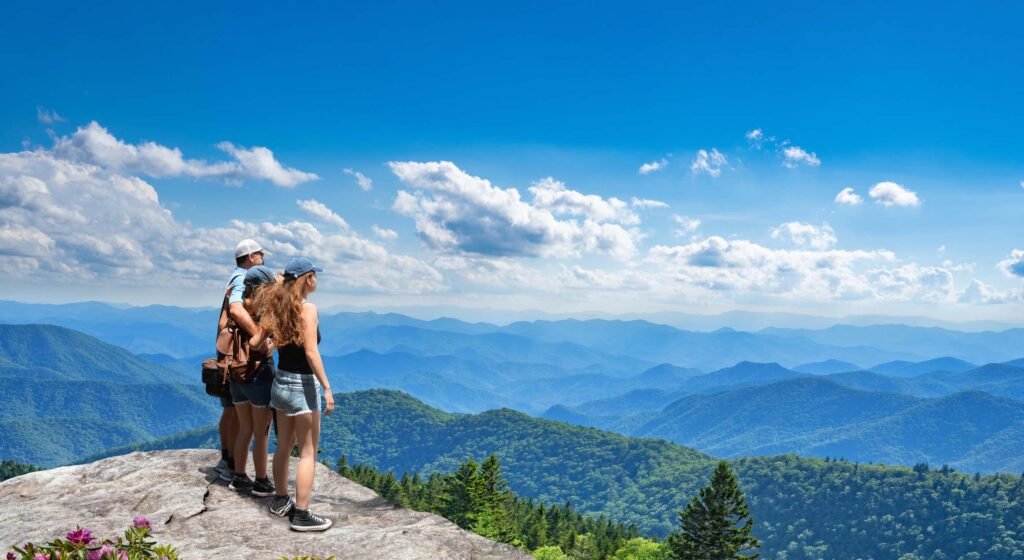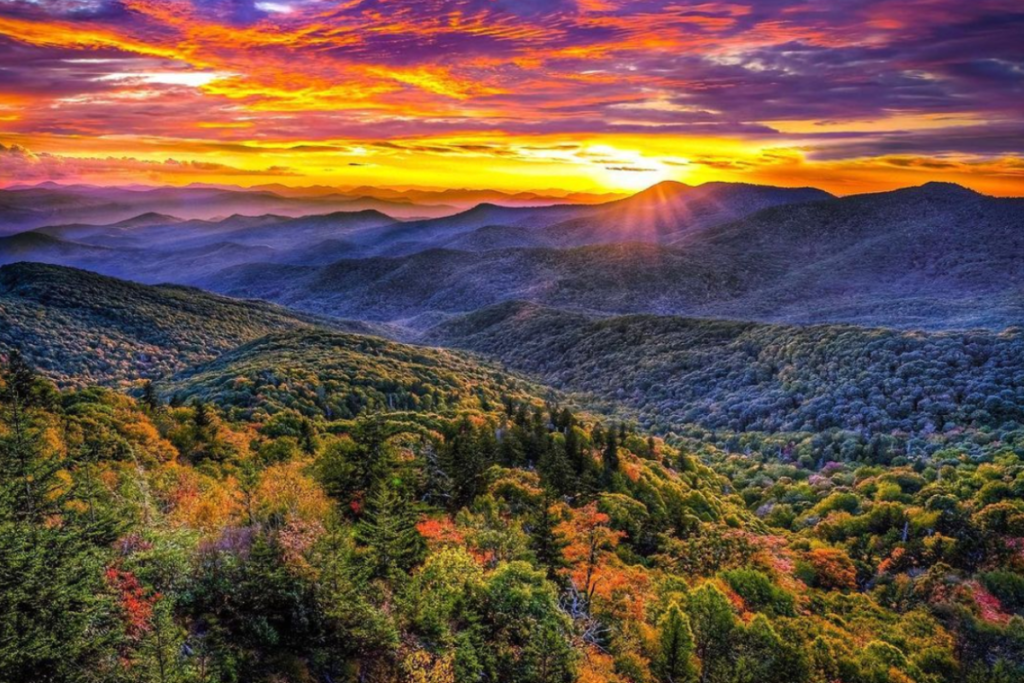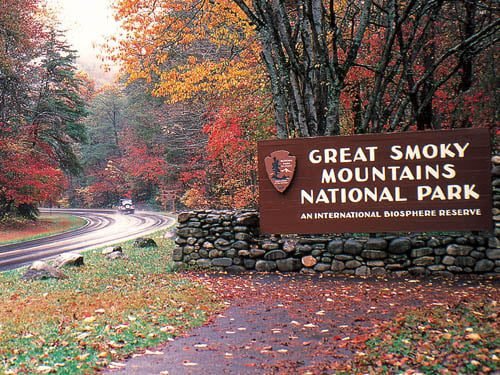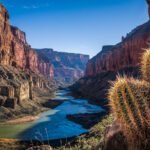Straddling the border of North Carolina and Tennessee, Great Smoky Mountains National Park offers over 800 square miles of pristine mountain wilderness in the eastern United States. With stunning vistas, an incredible diversity of plants and animals, and endless opportunities for adventure, it’s easy to see why this is America’s most visited national park. Use this comprehensive guide to plan your own escape into the majestic natural paradise of the Great Smoky Mountains.
The Great Smoky Mountains National Park is one of the most popular national parks in the United States. The park ranks #2 on the list of Top 10 Best National Parks in the country, welcoming over 11 million visitors per year. With its incredible biodiversity, an abundance of activities, and majestic mountain scenery, it certainly deserves this top spot.
For more information directly from the National Park Service, visit the Great Smoky Mountains National Park website to access up-to-date resources on planning your visit. The NPS site has details on facilities, fees, park alerts, maps, and more useful trip-planning details.
Overview of Great Smoky Mountains National Park
Established in 1934, Great Smoky Mountains National Park is renowned as an ecologically diverse sanctuary. Here are some key facts about the park:
- Largest national park in the Eastern US spanning over 500,000 acres
- Divided into north and south sections, bisected by Newfound Gap Road
- The main park entrances at Gatlinburg, TN, and Cherokee, NC
- Protects one of the oldest mountain ranges in the world, rich in biodiversity
- Temperate climate with hot, humid summers and mild falls and winters

The park’s sculpted peaks, lush forests, cascading waterfalls, and scenic overlooks provide endless opportunities for exploration and enjoyment.
When to Visit the Great Smoky Mountains
Great Smoky Mountains National Park offers spectacular scenery throughout the year. Here are some things to consider when planning your visit during different seasons:
- Spring (March-May) – Wildflowers bloom while rainfall keeps everything lush and green. Temperatures are mild but some rainfall is expected.
- Summer (June – August) – The busiest season with long days for hiking. Temperatures get hot and humid with afternoon thundershowers.
- Fall (September – November) – Dramatic fall foliage with moderate temperatures and fewer crowds after Labor Day.
- Winter (December – February) – Frigid temperatures with snow at higher elevations. Trails and roads can be closed—the lowest visitation of the year.

Getting to the Great Smoky Mountains
Most visitors access the Great Smoky Mountains National Park by car. Major roads providing entrance include:
- Gatlinburg, TN – The most popular entrance on the park’s south side with visitor centers, viewpoints like Clingman Dome, and links to Cherokee, NC.
- Cherokee, NC – Provides access to the south side of the park including the historic Cades Cove area.
- Townsend, TN – Quieter entrance to the northwest section of the park. Close to Cades Cove and the Foothills Parkway.
- Cosby, TN – Accesses the northeast section of the park near Cosby Campground and several trailheads.
There is no public transportation directly to the park. However, free shuttle buses operate within the park to help visitors get around once inside.
Top Sights and Activities
With over 800 miles of hiking trails, waterfalls, scenic drives, diverse wildlife, rich history, and stunning vistas, the Great Smoky Mountains offer endless sights and adventure. Here are some highlights:
Scenic Drives
Wind through mountain valleys and rolling hills on roads like:
- Newfound Gap Road – Crosses the entire park over the mountains with overlooks.
- Cades Cove Loop – Passes historic buildings, meadows, and wildlife viewing.
- Foothills Parkway – Runs along the outer border of the park with cascading views.
Hiking
Trails ranging from short nature walks to multi-day treks include:
- Alum Cave Trail – Steep path to overlooks and unique rock formations.
- Ramsey Cascades – Follows a stream to the park’s tallest waterfall.
- Appalachian Trail – Winding 2,180 miles from Georgia to Maine, passing scenic highlights.
Waterfalls
Over 100 waterfalls cascade through the park’s verdant landscape:
- Grotto Falls – Accessible from the Roaring Fork Motor Trail.
- Abrams Falls – A 5-mile out-and-back hike rewards you with scenic plunges.
- Rainbow Falls – Named for the trout visible as mist catches the light.
Wildlife Watching
Spot diverse animals like:
- Black bears – Up to 1500 live in the park, especially active in spring. Keep food stored properly and maintain distance if spotted.
- White-tailed deer – Often seen grazing in meadows like Cades Cove.
- Synchronous fireflies – Photinus carolinus lights up the forest in early June.
Black bears are a common sight in the Smokies
Planning Your Visit
To make the most of your time, be sure to prepare properly for your visit:
- When to Go – Each season offers different benefits. Spring and fall are moderate while summer is busy and winter is cold.
- Where to Stay – Lodges, cabins, and campgrounds both in and around the park. Reserve early for peak times.
- What to Bring – Layered clothing, hiking shoes, bug spray, sun protection, water bottles, and camera gear.
- Park Fees – No entrance fees but some parking fees at visitor centers and busy trailheads.
- Visitor Centers – Stop to get activity advice, trail maps, permits, and listen to ranger talks.
- Safety – Always store food properly, watch for wildlife, stay on trails, tell someone your plans, and bring enough water.
Proper preparation will help ensure you have an enjoyable and safe visit.
North vs. South Sections
The park contains unique sights and attractions in both its northern and southern sections:
North Section
- Quieter with fewer crowds and services
- Higher mountain peaks and balds
- Access to Appalachian Trail sections
- Some roads like Clingmans Dome Road close seasonally
South Section
- More developed with visitor centers and towns like Gatlinburg, TN nearby
- Lower-elevation valleys like Cades Cove
- Historic mills, churches, and homes
- Close to Cherokee, NC with native heritage
Must-See Highlights
With endless sights, here are a few spots not to miss:
- Clingman’s Dome – The highest point in the park with a futuristic observation tower.
- Newfound Gap – A scenic mountain pass along the state border.
- Cades Cove – Historic cabins, churches, and abundant wildlife viewing opportunities.
- Alum Cave Bluffs – Iconic overlook accessed by a steep hike with great payoff views.
Make time to take in these quintessential Smoky Mountain sights and plan your route to hit other highlights nearby.
Frequently Asked Questions
How long does it take to drive across the park?
It takes about 2.5 hours to drive the full length of the Great Smoky Mountains National Park via Newfound Gap Road between Cherokee, NC, and Gatlinburg, TN covering around 35 miles.
What is there to do in the winter?
Winter activities include snowshoeing and cross-country skiing on trails like Laurel Falls, photographing snowy scenes, and spotting wildlife. The higher peaks have snow while valleys are often warmer.
Where are the best places to see fall colors?
Popular autumn foliage spots include Newfound Gap Road, Clingmans Dome, Cataloochee Valley, and Cades Cove. The peaks turn first so visit early in the season.
Is camping allowed in the park?
Yes, there are 10 campgrounds in the park from large developed sites with amenities to more remote backcountry options. Sites book up early so reserve well in advance.
What tips do you have for hiking?
Bring proper footwear like trail runners, plenty of water, snacks for energy, first aid supplies, rain gear, and maps, and let someone know your plans. Start early before the midday heat.
With its endless sights, activities, and natural diversity, Great Smoky Mountains National Park offers an escape into true mountain wilderness. Use this guide to plan your own adventure into this treasured national park. Let the rolling peaks, lush forests, and cascading falls refresh your spirit!









